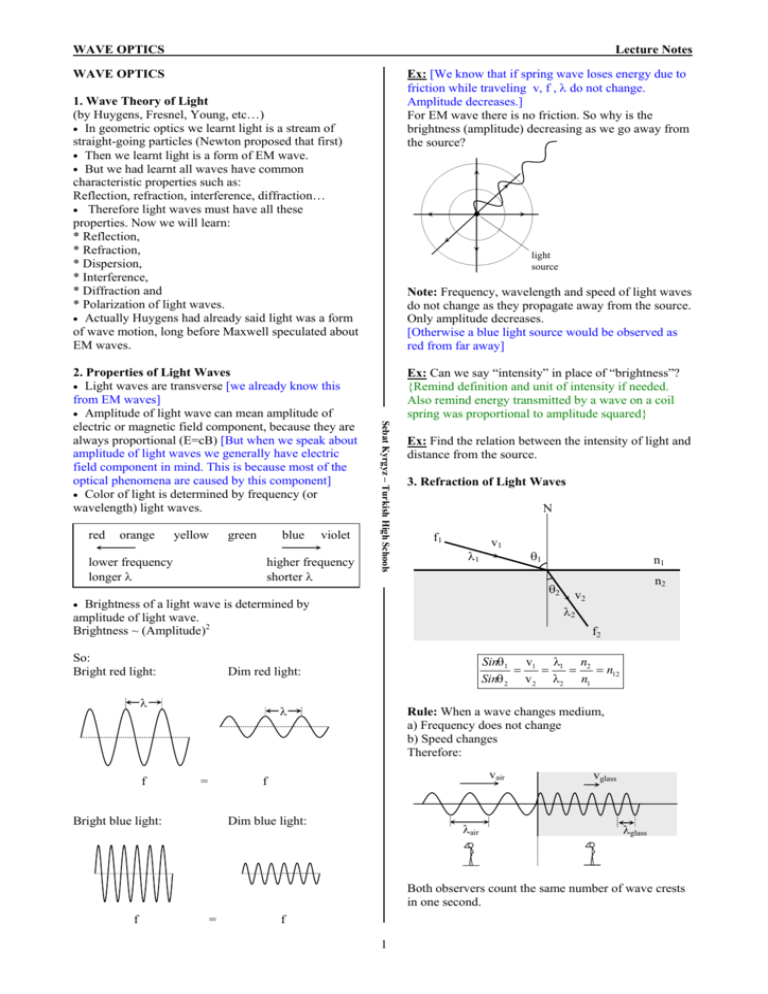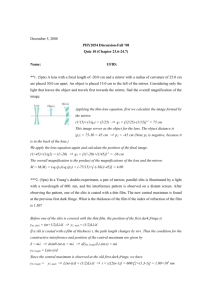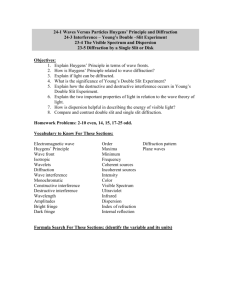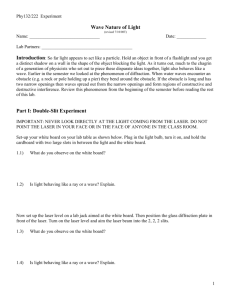WAVE OPTICS Lecture Notes
advertisement

WAVE OPTICS
Lecture Notes
WAVE OPTICS
Ex: [We know that if spring wave loses energy due to
friction while traveling v, f , λ do not change.
Amplitude decreases.]
For EM wave there is no friction. So why is the
brightness (amplitude) decreasing as we go away from
the source?
1. Wave Theory of Light
(by Huygens, Fresnel, Young, etc…)
• In geometric optics we learnt light is a stream of
straight-going particles (Newton proposed that first)
• Then we learnt light is a form of EM wave.
• But we had learnt all waves have common
characteristic properties such as:
Reflection, refraction, interference, diffraction…
• Therefore light waves must have all these
properties. Now we will learn:
* Reflection,
* Refraction,
* Dispersion,
* Interference,
* Diffraction and
* Polarization of light waves.
• Actually Huygens had already said light was a form
of wave motion, long before Maxwell speculated about
EM waves.
red
orange
yellow
green
lower frequency
longer λ
blue
violet
higher frequency
shorter λ
Note: Frequency, wavelength and speed of light waves
do not change as they propagate away from the source.
Only amplitude decreases.
[Otherwise a blue light source would be observed as
red from far away]
Ex: Can we say “intensity” in place of “brightness”?
{Remind definition and unit of intensity if needed.
Also remind energy transmitted by a wave on a coil
spring was proportional to amplitude squared}
Sebat Kyrgyz – Turkish High Schools
2. Properties of Light Waves
• Light waves are transverse [we already know this
from EM waves]
• Amplitude of light wave can mean amplitude of
electric or magnetic field component, because they are
always proportional (E=cB) [But when we speak about
amplitude of light waves we generally have electric
field component in mind. This is because most of the
optical phenomena are caused by this component]
• Color of light is determined by frequency (or
wavelength) light waves.
light
source
Ex: Find the relation between the intensity of light and
distance from the source.
3. Refraction of Light Waves
N
f1
λ1
v1
f
f2
Sinθ1 v1 λ1 n2
=
=
=
= n12
Sinθ 2 v 2 λ2 n1
λ
=
Rule: When a wave changes medium,
a) Frequency does not change
b) Speed changes
Therefore:
vair
f
Bright blue light:
n2
v2
λ2
Dim red light:
λ
n1
θ2
• Brightness of a light wave is determined by
amplitude of light wave.
Brightness ~ (Amplitude)2
So:
Bright red light:
θ1
Dim blue light:
λair
vglass
λglass
Both observers count the same number of wave crests
in one second.
f
=
f
1
WAVE OPTICS
Lecture Notes
sources become completely out of phase, central line
becomes a node, (say) 0.36 second later they become
in phase again and central line is an antinode. So we
will not see any interference pattern]
Special case: If light is coming from air
λ
λglass = air because nair=1
nglass
Caution: Drawing this figure
for a
light wave does NOT mean that light rays move up and
down in the air. [The figure is trying to say that electric
field at a point is increasing and decreasing
(oscillating) as the light passes by. This oscillation
itself is called light.
Remember: In water waves,
Question: [When we have two wave sources on water,
we see several nodes on water surface where waves
from two sources cancel]. Why don’t we ever see light
waves from two lamps cancel each other and some
points in the room become dark (= node)?
Answer: {Explain the reason, why two light bulbs (or
any other ordinary light sources) can never be
coherent, then ask the students to find a way for
obtaining two coherent light sources}
v
5.a. Young’s Experiment
To obtain two coherent light sources Thomas Young
used one single light source and made the light pass
through two slits (slit = a long narrow opening). Now
each slit is like a light source.
each water molecule is moving up and down as a crest
or trough passes by. But we do not say the water wave
is following a sinusoidal path. When we are asked to
draw the path of the wave, we draw a straight arrow
showing direction of motion in general, not motion of
particles. And since the wave is transverse, direction of
motion is perpendicular to up-down motion of
particles.]
white
Sebat Kyrgyz – Turkish High Schools
4. Dispersion of Light Waves
Dispersion means dependence of index of refraction of
a medium on the frequency (or wavelength) of the
incident light.
That is, for example:
nglass ≠ 1.5 = constant
nglass = n (λ)
for red light nglass= 1.513
for blue light nglass= 1.528
Therefore:
Note: To obtain a better visible interference pattern
sources must be monochromatic (of one color = having
single λ).
s1
s0
s2
slits
On the screen we see:
screen
We simply draw:
air
glass
blue
dark
bright
red
5. Interference of Light Waves
Coherence:
If two wave sources are “coherent” they always have
the same phase difference between them. [If they are in
phase at the beginning, they are always in phase. If
they start 180° out of phase they will still be 180° out
of phase 10 minutes later]
[If two waves are coherent at a point in space, they
always have the same phase difference at this point in
space]
• If two wave sources are coherent, the interference
pattern is stable and observable. [Nodes and antinodes
will always be at the same place, we will be able to see
them]
• If two wave sources are incoherent, the interference
pattern is not observable. [Think about central line in
ripple tank. Suppose now the sources are in phase, and
central line is an antinode, (say) 0.23 second later
Note: These dark and bright bands are called “fringes”.
Remember: Node for water ⇒ Dark for light
Antinode for water ⇒ Bright for light
[Actually there are no definite boundaries between
dark and bright fringes. Only the center of a dark fringe
is totally dark and center of a bright fringe is maximum
bright]
Class demo: Hold a thin glass plate over the flame of a
candle. When it is black enough draw two slits with a
razor blade. Illuminate the slits with a laser beam. Use
a white paper 1 meter away as the screen.
2
WAVE OPTICS
Lecture Notes
Condition for dark-bright:
Path difference (δ):
P
P
r1
s1
δ ≡ r1 − r2
s1
r2
d
s2
s2
slits
δ = 3λ - 2.5λ = 0.5 λ
A
δ
screen
P
Finding δ from geometry:
Approximation:
s1
P
s1
d
A
θ
d
s2
δ A
s2
Sebat Kyrgyz – Turkish High Schools
L
[d: Distance between sources
L: slits-screen distance]
Since L ~ 1 meter
d ~ 0.1 mm;
L>>>d so we can take s1 P & s2 P
therefore: |s1P| ≈ |AP|
therefore: s2 A = r1 − r2 = δ
δ = d Sinθ
therefore:
[This formula seems to be totally useless, because we
can not even see θ let alone measuring it. But:]
δ
dark
δ = 0.5 λ
δ = 1.5 λ
δ = 2.5 λ
δ = 1.5 λ
bright
δ=0
δ=1λ
δ=2λ
Dark
Bright
1
δ = m − λ
2
1
d Sinθ = m − λ
2
y
1
d = m − λ
L
2
d Sinθ = mλ
1
λL
ym =
m −
2
d
λL
ym =
m
d
m = 1, 2,3...
m = 0N ,1, 2,3...
How to measure Sinθ:
δ = mλ
d
central
line
P
s1
~L
θ
θ
d
s2
y
= mλ
L
for dark
y
for bright
central
line
m=3
m=2
δ
m=2
m=1
L
y
m=1
m=0
slits
m=-1
screen
d: Distance between slits
L: Slits-screen distance
y: Distance from central line to a point on a fringe
y
δ = d Sinθ ⇔ δ = d
L
laser
Note: Central line is bright
Note: We have m=2 for dark, m=2 for bright
Note: y starts from central line
Note: m is always integer
3
m=-2
WAVE OPTICS
Lecture Notes
Ex: Suppose while performing double-slit experiment,
the space between the slits and the screen is filled with
water. How does the interference pattern change?
Fringe width (∆y):
m=2
Ex: A double-slit arrangement is illuminated first with
red, then with blue light.
a) Which one has wider fringes?
b) Which one produces more fringes?
∆y
y2
m=1
y1
m=1
∆y
Central
line
Ex: What happens if we use white light in place of
monochromatic light in Young’s experiment?
Answer: Think about light of two color only (red-blue)
m=2
only red:
only blue:
together:
[Since there is no definite boundaries between dark and
bright fringes, we take the region between two absolute
darks (at the center of the dark fringe) as the width of a
bright fringe.]
∆y=y2-y1
λL
1 λ L 1
∆y =
2 − −
1 −
2 d 2
d
λL
d
Note: Units used for λ.
1 µm = 10-6 m (micrometer)
1 nm = 10-9 m (nanometer)
D
1 A = 10-10 m (angstrom)
Ex:
Color
A
nm
m
red
blue
6000
4000
600
400
6 x 10-7
4 x 10-7
Sebat Kyrgyz – Turkish High Schools
∆y =
Ex: 6000 A laser light passes through two slits 0.1 mm
apart and reaches the screen placed 2 m away.
a) Find fringe width
b) Find position of second dark
c) Find position of third bright
{Draw figure after solution}
Intensity Distribution:
I
Rule: In double-slit interference, all fringes are equally
bright and wide. {Actually we are neglecting
diffraction effects for the time being. We take the slits
sufficiently small themselves so as to make diffraction
effects negligible. See N-slit diffraction}
6. Diffraction
Diffraction is bending of waves around an obstacle
(barrier) [or spreading of waves passing through a
narrow slit]
Ex: Laser light (5000 A) passes through a double slit
arrangement 0.05 mm apart. The screen is 1 m away
from slits.
a) Find fringe separation (=fringe width)
b) Find distance between 2nd bright and 3rd dark on
opposite sides.
{Draw figure during solution}
[We had seen diffraction with water waves
a
λ
Ex: What can we do to obtain a better visible pattern in
Young’s experiment?
{Explain effect of changing λ, d and L on ∆y. Draw
two example patterns for small and large d}
Diffraction amount depends on
If a>>λ diffraction is negligible.
[Result: Slits closer, fringe centers distant. Slits distant,
fringe centers closer]
4
λ
proportion.
a
WAVE OPTICS
Lecture Notes
Now condition for first dark:
λ
λ
a
δ =
⇒
Sinθ =
2
2
2
a Sin θ = λ (first dark)
[First dark is important, because between two first
darks we have the central bright, which receives nearly
all the light energy passing through the slit]
if we divide the slit into 4, 6, 8, (even number) equal
parts [and set δ=λ/2 we will have (a/4)Sinθ=λ/2,
(a/6)Sinθ=λ/2, (a/8)Sinθ=λ/2…] we get condition for
other darks {explain relation between even number and
dark}:
Same phenomenon is observable with light waves.
Since λ of light is very small, the openning must also
be very small, something like 0.1 mm]
Single slit diffraction:
Dark
a Sinθ = mλ
a
Bright
a Sinθ=(m+1/2)λ
ym
= mλ
L
ym =
a
λL
m
a
ym =
m=1,2,3…
Actual pattern:
We simply draw:
Sebat Kyrgyz – Turkish High Schools
[Most of the light energy is concentrated at the central
maximum. Actually it is possible to say that all the
light passing through the slit is spread as wide as the
central maximum simply omitting the other bright
fringes]
ym
1
= m + λ
L
2
1
λL
m+
a
2
m=1,2,3…
[We don’t have m=0 for central bright. Central bright
is determined by position of first darks]
Ex: How have we found condition for brights?
Sol: Divide the slit into 3, 5, 7, (odd number) parts:
For first bright (m=1) we divide the slit into 3 equal
portions. [Because “dividing” into 1portion gives us
the central bright]
3
2
1
3
2
1
3
2
1
a 3
θ
a 3
a 3
δ =
a
3
Sinθ
a
λ
Sinθ = waves from two
3
2
portions cancel but the remaining third portion
illuminates the point on screen. So for first bright
3
1
m = 1 ⇒ a Sinθ = λ = m + λ
2
2
For first bright (m=1) δ =
[We still have dark fringes althought there is only one
slit. Therefore light waves coming from different
portions of the slit must be canceling]
If we divide the slit into two equal portions:
3
2
a 2
a 2
θ
1
3
2
1
Ex: Derive fringe seperation formula ∆y=?
λL
∆y =
[same between centers of brights and darks,
a
only central bright 2∆y]
to point P
θ
Ex: 5000 A monochromatic light passes through a slit
having 0.05 mm width. How much does it spread?
a
δ = Sinθ
2
5
WAVE OPTICS
Lecture Notes
Sol: θ1 for first dark:
a Sinθ=mλ
Sinθ1 (dark ) =
m=1⇒ a Sinθ = λ
[Imagine otherwise, we would be able to send mors
code messages to an astronout on the moon by using a
simple diode laser.]
λ
a
* We don’t have sharp shadows of objects even with a
point light source.
Sinθ1=5 x 10-7 / 10-5 =0.05
θ1≈ 3°
Ex: Diffraction from an edge (not a slit)
point source
m=1 dark
3°
3°
object
m=1 dark
L
shadow
Ex: What is the minimum slit width for no diffraction
minimum (dark fringe) to be observed?
If there wasn’t diffraction:
Note: Boundary between geometric optics and wave
optics:
There is no definite limit. Depends on:
- Width of light source
- Distance light travels
{Explain using the example below}
L
Ex: Monochromatic light (λ=6000 A) passes through a
slit 0.1 mm wide and illuminates a screen 2 m away.
Find width of central bright on screen.
Answer:
2∆y= 12 mm =1.2 cm
Sebat Kyrgyz – Turkish High Schools
Bright spot as
wide as the slit
1.2 cm
bright
fringe
0.1 mm
screen
Ex: What is the maximum slit width for diffraction?
[Answer: If the light source is coherent, diffraction
always occurs for all openings even if the slit is large.
λ
(first dark) , if
But according to formula: Sin θ =
a
a>>λ, then θ is very small. So diffraction effect
becomes negligible over small distances. The light
follows nearly a straight path as wide as the slit for
small distances if the slit dimension is large. But over
large distances a small angle causes a a large
seperation. If we are trying to send a 5 mm wide laser
ray from earth to moon for example, the spreading of
the beam will be ~ 0.01°, which is negligible at the
beginning. But when it reaches the moon, the beam
will be as wide as ~ 80 km!.]
7. Resolving Power
Two light sources are seen as a single source if they are
far away enaugh. [Many bright dots in the night sky are
actually star pairs – not sinle stars. Enother example
can be the two headlights of a car approaching from a
distance]
The reason is diffraction. When light from the sources
passes through the pupil of the eye, [which is a circular
opening of ~2-3 mm] diffraction occurs. The retina acts
as a screen.
If there was not diffraction:
2m
If there wasn’t diffractionthere would be a bright spot
0.1 mm wide on the screen.
Ex: Laser light having 6000 A wavelength passes
through a slit 0.2 mm wide. On a screen placed 1 m
away find
a) Distance from central line to second bright
b) Distance between second dark and third bright on
different sides.
Ex: What are the effects of diffraction?
* We can not send a light ray along a straight path for a
long distance. It will spread and lose intensity.
[Actually this is the case for any type of EM wave]
sources
screen
6
WAVE OPTICS
Lecture Notes
Because of diffraction:
8. Diffraction Grating
{Demo: N-slit diffraction java applet}
[The diffraction grating is a more useful device to
analyse lights sources, because the interference
maximums (bright fringes) are thin lines, making the
measurements easier]
θ
sources
screen
When θ gets smaller patterns overlap and seen as one:
d
not resolved
(seen as one)
Rule: Two sources seen as one when central bright of
one pattern is on the first dark of the other.
resolved
Intensity
δ = d Sinθ
Therefore; m’th BRIGHT fringe:
d Sinθ = m λ
(m = 0, 1, 2, 3 …)
d θ
Therefore:
L
x
θ
sources
First dark:
d Sinθ = λ
⇒
λ
Sinθ =
a
x λ
=
(just resolved)
L a
screen
x λ
>
L a
x λ
<
L a
Sebat Kyrgyz – Turkish High Schools
m=1
to point P
on screen
two sources seen
seen as one source
δ
[Therefore we can use two slit formulas]
[We are not writing formula for dark
fringe because dark friges are actullly
wide dark bands between two bright
lines]
Ex: A diffraction grating has 500 slits in 1 cm.
a) Find slit spacing
b) Find λ of monochromatic light if first maximum
(bright fringe) occurs 3.5 cm from the central line on a
screen 1 m away.
Ex: Monochromatic light of 650 nm wavelength is
incident on diffraction grating having 2x10-6 m slit
spacing.
a) How many bright lines will be observed?
b) What is the angular position of the first diffraction
fringe ?
Ex: What is the path difference for the light waves
forming the bright fringe at 30° from the central
bright? Slit spacing of the diffraction grating is 0.05
mm.
{Actually these formulas are for slits, and can be used
for a cat for example. For circular apertures we have a
factor of 1.22 which we neglected here}
Ex: A diffraction grating is illuminated by mixed red
and blue light. Second bright of red coincides with the
third bright of blue. Find λblue=?, if λred= 6000 A.
Ex: From what distance can we see two headlights of a
car as two?
Distance between lights 1.5 m, take λ=5000A.
[The actual distance is much smaller due to other (such
as atmosheric conditions. Diffraction is the ultimate
limit in our ‘seeing’ power and since there are always
other factors limiting our vision we are seldom limited
by diffraction effects]
Ex: How many slits in 1 mm must a diffraction grating
have, if it is to be used to analyse light having
wavelength around 0.5 µm?
[Ex: Explain whys we can’t ever see an atom with
normal light no matter how powerful a microscope we
use. That is, explain how diffraction puts a limit to
seeing small objects]
Ex: Explain why very large dishes are used for
radiotelescopes.
7
WAVE OPTICS
Lecture Notes
No phase
difference
9. Interference in thin films
Extreme case 1:
this side dark
(no transmission)
this side bright
crest
crest
Glass
Air
light of
single λ
crest
Free end
soap film
[Rule: light rays undergo 180° phase change upon
reflection from an optically denser (with greater index
of refraction) medium.]
Extreme case 2:
this side dark
(no reflection)
this side bright
Formula:
For observer looking from above:
180° phase
difference
light of
single λ
no phase
difference
soap film
A soap bubble has two sides:
reflected 2
reflected 1
incident
side 1
d
Sebat Kyrgyz – Turkish High Schools
In intermediate cases light is partly transmitted, partly
reflected.
{Ask students: soap bubble is normally transparent,
how can it stop light. Why soap bubble? Is it because it
is very thin?}
Rule:
Remember waves on a spring. Light waves have the
same property.
180° phase
difference
Fixed end
λ film =
λair
n film
{Explain 2d}
λ film
1
2d ±
= (m − )λ film
2
2
equivalent
path difference
Looking from above:
[Looking from above means the light source and the
observer are on the same side of the soap film]
2d = mλ film ⇔ Dark m = 0, 1, 2, 3, 4…
crest
Air
For destructive interference (dark):
1
Path difference = (m − )λ film
2
[We can add or subtruct λ/2. This just means we take
one wave as being λ/2 in front of or behind the other,
which is not important because the situation is
symmetrical. We will use the minus sign, because
when we use the minus sign, we can start from m=0 ⇒
zero thickness. Otherwise we would start from
m = -1,which is possible but not very nice. Remember
m is just a counting number, 1st order dark, 2nd order
dark etc.]
side 2
Light rays reflecting from two sides can cancel or
reinforce according to phase difference between them.
180°
phase
diff
[So between two reflected rays there is 180° phase diff]
λ
180D phase difference ⇔
path difference
2
trough
Glass
Therefore:
crest
1
2d = m − λ film ⇔ Bright m = 1, 2, 3, 4…
2
[m=0 ⇒ zero thickness. How can this happen? We will
see in a minute]
8
WAVE OPTICS
Lecture Notes
{Film thickness is adjusted to wavelength of yellow
light, since it is the most intense component of
sunlight}
For observer looking from below:
Ex: Solar cells are also coated with thin films. Why?
d
no phase
difference
Ex: Thin coating. Find the formula for thickness of
film, if no light of wavelength λ is to reflect back.
no phase
difference
light (λ)
d
film (n=1.2)
glass (n=1.6)
observer
For destructive interference (dark):
1
Path difference = (m − )λ film
2
1
2d = m − λ film ⇔ Dark m = 1, 2, 3, 4…
2
Solution:
180° phase
180° phase
difference
difference
Dark:
n=1
Therefore:
2d = mλ film ⇔ Bright m = 0, 1, 2, 3, 4…
Ex: 6000 A laser light is incident on a soap film
(n=1.5). What is the minimum thickness of the film for
the light not to be able to pass to other side.
Ex: 6000 A laser light is incident on a soap film
(n=1.5). What is the minimum thickness of the film for
the light not to reflect back from the film surface.
Ex: 6000 A laser light is incident on a soap film
(n=1.5). Find three different thicknesses the film might
have, if the light is not reflecting back.
Sebat Kyrgyz – Turkish High Schools
Formulas changed place
Therefore:
One side dark ⇔ other side bright.
n=1.2
Ex: Film of changing thickness. [If you hold a soap
film vertically lower side becomes thicker.]
red light
m=3
(bright)
m=4
(dark)
m=0
(dark)
d4 (dark)
d3 (bright)
Ex: Explain why we see many different colors over a
soap film.
Ex: Lenses used in a camera are generally coated with
a thin film of definite thickness. Why?
9
n=1.5
10. Air Wedge
d
1
2d = m − λ
2
m = 1, 2,3...








